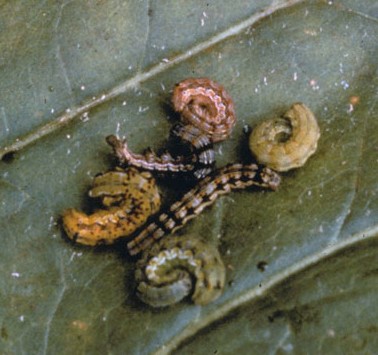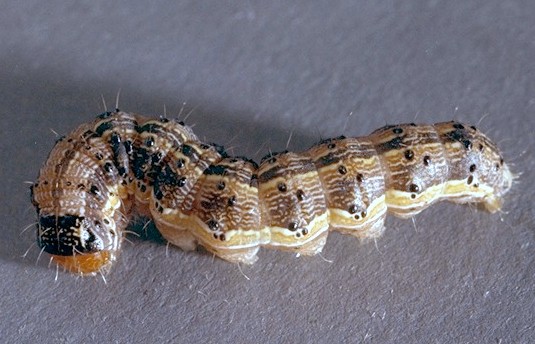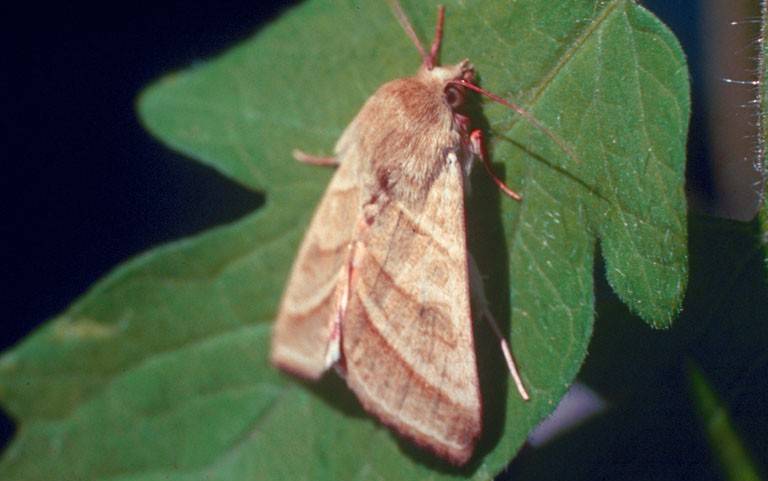Corn Earworm, Cotton Bollworm, Tomato Fruitworm
 Scientific Name
Scientific Name
Helicoverpa zea
Host
The vegetables most commonly damaged are corn and tomatoes but earworms will also feed on several other vegetables, many field crops, some ornamentals, and a wide variety of wild plants. The name of the caterpillar is often based on the host plant, e. g. corn earworm, tomato fruitworm, cotton bollworm, soybean podworm, or sorghum headworm.
Symptoms
Damage to com is by feeding in the terminals of young plants and in the ears (on the kernels) of older plants. Tomatoes, and occasionally peppers, are damaged mostly by the larvae boring into the fruit. Larvae will feed on the leaves and pods of beans and cowpeas and on the pods of okra.
Life Cycle
 Earworms overwinter as pupae in the top inch or two of the soil. Adults begin to emerge
in late March or early April. Moths also migrate north from Texas to augment the population
that overwinters in Oklahoma. Eggs are laid on the buds or fruit of host plants. Larvae
feed for 21 to 25 days before entering the soil to pupate. They prefer buds or fruit
but will also feed on the leaves of many different plants. First generation larvae
are found mostly in alfalfa and seldom cause problems in vegetables. Second generation
larvae commonly damage com, beginning in mid-May. Damage to tomatoes is seldom seen
before June but may continue into early October. There are at least 4 generations
per year.
Earworms overwinter as pupae in the top inch or two of the soil. Adults begin to emerge
in late March or early April. Moths also migrate north from Texas to augment the population
that overwinters in Oklahoma. Eggs are laid on the buds or fruit of host plants. Larvae
feed for 21 to 25 days before entering the soil to pupate. They prefer buds or fruit
but will also feed on the leaves of many different plants. First generation larvae
are found mostly in alfalfa and seldom cause problems in vegetables. Second generation
larvae commonly damage com, beginning in mid-May. Damage to tomatoes is seldom seen
before June but may continue into early October. There are at least 4 generations
per year.
Description
 The adult moth is usually light yellowish olive with a single dark spot near the center
of each front wing, but some adults have vague darker markings on the wings. The wingspread
is about 1 1/2 inches. The eggs are almost spherical with a flattened base and white
or cream in color. The larvae come in a wide variety of colors, including shades of
pink, yellow, green, brown, and black. The color depends to some extent on the host
plant. They usually have darker or lighter stripes running lengthwise on the body.
They can be positively identified by the presence of short, sharp microspines between
the hairs on the body, but magnification of 7 to 10x is necessary to see these spines.
The adult moth is usually light yellowish olive with a single dark spot near the center
of each front wing, but some adults have vague darker markings on the wings. The wingspread
is about 1 1/2 inches. The eggs are almost spherical with a flattened base and white
or cream in color. The larvae come in a wide variety of colors, including shades of
pink, yellow, green, brown, and black. The color depends to some extent on the host
plant. They usually have darker or lighter stripes running lengthwise on the body.
They can be positively identified by the presence of short, sharp microspines between
the hairs on the body, but magnification of 7 to 10x is necessary to see these spines.
Control
Please contact your local county extension office for current information.
